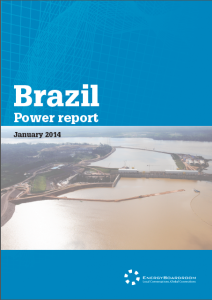Energyboardroom.com Releases New Brazil Power Report
Considering Brazil’s size and population, one would never imagine such a country being 64 percent reliant on hydro for its electricity; this is according to the National Agency for Electric Energy (ANEEL). However, Brazil made the choice to focus on renewable energies and capitalize on its natural resources. This South American nation is home to the second largest hydroelectric dam in the world, Itaipu, with an installed capacity of 14 GW; although it is some way behind China’s Three Gorges dam, with its installed capacity of 22.5 GW.
While hydropower has only reached one third of its total exploitation potential in Brazil, it is estimated that wind power alone has a potential capacity of 350 GW. However, the reality today is that wind represents only 2 percent of Brazil’s energy matrix, with solar power only taking its first steps.
In this climate, several questions spring to mind in relation to this South American country’s power sector. Is Brazil making the right choice by focusing on renewable energies? Are these energies competitive and attractive for international investors? Is the country prepared to balance its federal and regional agendas given such high economic and social disparities between regions? How will it meet the yearly 5 percent increases in energy demand? Download the new report from EnergyBoardroom today and find out what the leading executives from across the Brazilian power sector have to say in response.
Featuring:
José da Costa Carvalho, President, Eletrobras
Dr. Albert C. Geber de Melo, Director General, Eletrobras Research Center Cepel
João Bosco de Almeida, President Director – Chesf
Romeu Rufino, President, ANEEL: Brazil’s National Electric Energy Agency
Hermes Chipp, General Director ONS: Brazil’s National Operator of Electric Systems
Luis Fernando Leone Vianna, President, APINE (Brazilian Association for Independent Electric Energy Producers)
Humberto Barbato, President, ABINEE (Brazilian Electrical and Electronics Industry Association)
Thomas Hanson, Commercial Service Officer and Igly Seraphim, Business Development Specialist U.S. Commercial Service, U.S. Consulate, Sao Paulo
Sergio Parada, President, Andritz Hydro Inepar
Patrick Simon, President Director of EDF Norte Fluminense
Ana Maria Machado Fernandes, CEO, EDP Energias do Brasil
Jose Luis Menghini, Executive Vice President, IMPSA
Antonio Fernando Krempel, CEO of Intertechne
Rafael Jaramillo, Vice President & General Manager, Emerson Process Management
Paulo Fernando Soares, General Manager, Vestas
Michael Comi
Focus Reports
+44 203 356 4889
email us here
Legal Disclaimer:
EIN Presswire provides this news content "as is" without warranty of any kind. We do not accept any responsibility or liability for the accuracy, content, images, videos, licenses, completeness, legality, or reliability of the information contained in this article. If you have any complaints or copyright issues related to this article, kindly contact the author above.

